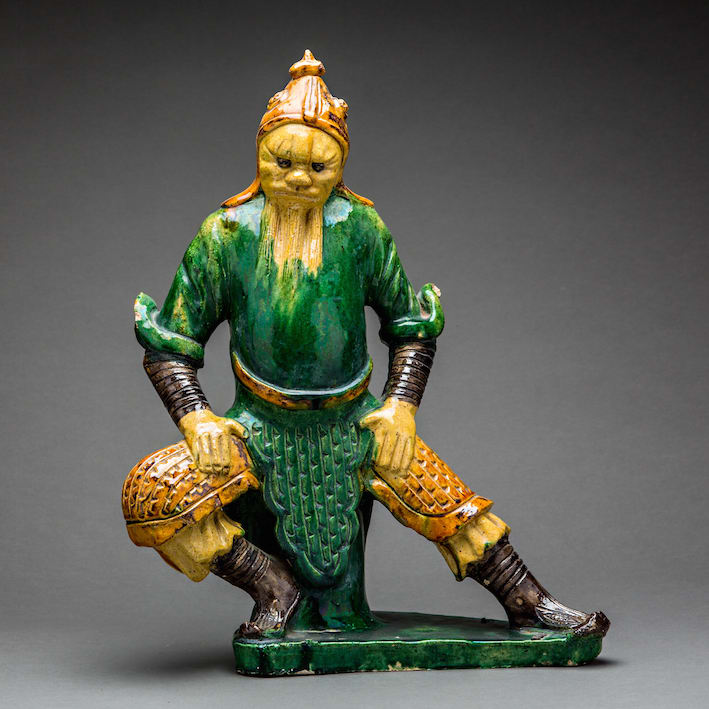Pair of Sancai Glazed Roof Tiles in the form of Standing Warriors, 1368 CE - 1644 CE
Glazed Terracotta
height 43.8 cm
height 17 1/4 in
height 17 1/4 in
LA.521
Further images
Pair of superb terracotta roof tiles in the form of two standing warriors; each sculpted in the round in opposing, wide-legged stance, upon integral base. Figure A (left) stands with...
Pair of superb terracotta roof tiles in the form of two standing warriors; each sculpted in the round in opposing, wide-legged stance, upon integral base.
Figure A (left) stands with weight rested on bent left leg, right leg extended straight; right arm crooked at elbow, hand clenched in fist against torso; left hand rested on left leg; ample visage with fleshy, almost ape-like features including furrowed brow, wide nose and mouth in grimace, framed by tightly-fitting leather-style cap on head and long beard that touches the chest; wears green tunic belted around the middle with waist cushions, over yellow trousers and brown boots.
Figure B (right), similar, but with weight rested on bent right leg, both hands on thighs; sleeves of tunic rolled up to the elbow revealing arm guards (vambraces); front panel of tunic distinguished by scalloped-edge and brigandine; brigandine leg guards worn over trousers. This exquisite pair of tiles herald from the Ming Dynasty (ACE 1368-1644) and would have been displayed along imperial ridges and reserved for the most important buildings. In addition to their expressive quality and arresting physiognomy, the distinct sancai-glaze, literally meaning three glazes, appeals for its brilliant colours and ability to vividly evoke the dazzling, luxurious cosmopolitan life of Imperial China. Above and beyond aesthetic merit, they are thought to constitute an accurate index as to Ming armoury. The highlight of any collection.
Figure A (left) stands with weight rested on bent left leg, right leg extended straight; right arm crooked at elbow, hand clenched in fist against torso; left hand rested on left leg; ample visage with fleshy, almost ape-like features including furrowed brow, wide nose and mouth in grimace, framed by tightly-fitting leather-style cap on head and long beard that touches the chest; wears green tunic belted around the middle with waist cushions, over yellow trousers and brown boots.
Figure B (right), similar, but with weight rested on bent right leg, both hands on thighs; sleeves of tunic rolled up to the elbow revealing arm guards (vambraces); front panel of tunic distinguished by scalloped-edge and brigandine; brigandine leg guards worn over trousers. This exquisite pair of tiles herald from the Ming Dynasty (ACE 1368-1644) and would have been displayed along imperial ridges and reserved for the most important buildings. In addition to their expressive quality and arresting physiognomy, the distinct sancai-glaze, literally meaning three glazes, appeals for its brilliant colours and ability to vividly evoke the dazzling, luxurious cosmopolitan life of Imperial China. Above and beyond aesthetic merit, they are thought to constitute an accurate index as to Ming armoury. The highlight of any collection.





